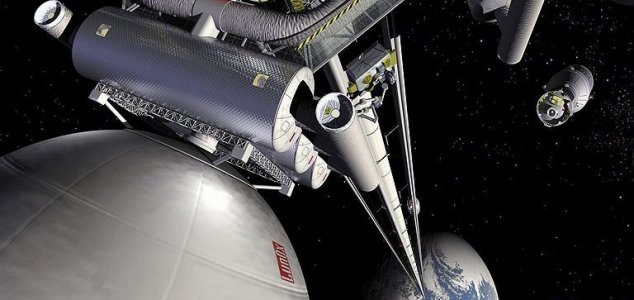Space & Astronomy
September 6, 2018 · 18 comments
18 comments

Is it possible to build an elevator in to space ? Image Credit: NASA
While the idea itself certainly has merit, finding a material capable of sustaining such an enormous structure has long proven to be a problem - as has developing a way to construct something that would ultimately need to be tens of thousands of miles high.
Now in a renewed bid to turn this idea into reality, scientists at Japan's Shizuoka University have been working with the Japan Aerospace Exploration Agency to launch a trial mission that will see a miniature payload being transported between two cubesats.
This small-scale demonstration of a space elevator concept, which will go ahead next week, will involve a cable only ten meters long and an 'elevator' a mere 6 centimeters long.
If the test works however it will show that the idea of a space elevator really does have potential.
"It's going to be the world's first experiment to test elevator movement in space," said a spokesman.
Source: Popular Mechanics | Comments (18)
Japan set to test miniature space elevator
By T.K. RandallSeptember 6, 2018 ·
 18 comments
18 comments
Is it possible to build an elevator in to space ? Image Credit: NASA
Scientists in Japan are aiming to one day build an elevator that can carry people and cargo in to orbit.
The idea of building a space elevator to bypass the need for expensive rocket launches is something that has been mulled over by scientists and engineers for years.While the idea itself certainly has merit, finding a material capable of sustaining such an enormous structure has long proven to be a problem - as has developing a way to construct something that would ultimately need to be tens of thousands of miles high.
Now in a renewed bid to turn this idea into reality, scientists at Japan's Shizuoka University have been working with the Japan Aerospace Exploration Agency to launch a trial mission that will see a miniature payload being transported between two cubesats.
If the test works however it will show that the idea of a space elevator really does have potential.
"It's going to be the world's first experiment to test elevator movement in space," said a spokesman.
Source: Popular Mechanics | Comments (18)

The Unexplained Mysteries
Book of Weird News
AVAILABLE NOW
Take a walk on the weird side with this compilation of some of the weirdest stories ever to grace the pages of a newspaper.
Click here to learn more

Support us on Patreon
BONUS CONTENTFor less than the cost of a cup of coffee, you can gain access to a wide range of exclusive perks including our popular 'Lost Ghost Stories' series.
Click here to learn more
Ancient Mysteries and Alternative History
UK and Europe
Metaphysics and Psychic Phenomena
Spirituality, Religion and Beliefs
Total Posts: 7,768,342 Topics: 325,021 Members: 203,767
Not a member yet ? Click here to join - registration is free and only takes a moment!
Not a member yet ? Click here to join - registration is free and only takes a moment!































Please Login or Register to post a comment.